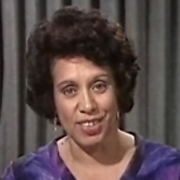
Marama Martin
Born and raised in New Plymouth, Marama Koea's first love was teaching. She was one of the first students at Ardmore Teachers' Training College, near Auckland. After time teaching in classrooms around the North Island, she headed off for Europe and the UK, arriving in London a week before the 1953 coronation of Queen Elizabeth II. She continued her teaching in the UK, but also landed a job as an extra in New Zealand-set adventure movie The Seekers, which featured Brit Jack Hawkins and Inia te Wiata. She remembered earning five pounds a day, a significant amount at the time.
By the late 50s she was back teaching in New Plymouth. Though keen on teaching she wanted to do something else and, in the end, stumbled into broadcasting.
She was looking for something that didn't clash with her day job and, with no clear idea of exactly what she would do there, approached the manager of the local radio station about evening or night work. He asked her to audition as an announcer and her career path was set for the next two decades.
She moved to Wellington in the early 60s, joining the staff of the NZ Broadcasting Corporation. Announcers in those days worked in both radio and television. In 1965 she began continuity announcing on TV. Contrary to popular belief, Martin wasn't the first Māori continuity announcer on television. Between October 1964 and April 1965 Tui Uru had filled that role for Christchurch's CHTV-3.
But Martin, by now married to Bert Martin, became a fixture, and was there when the national TV network began in 1969. She was connected to a further Kiwi TV milestone when, in October 1973, she was the first person seen in colour on New Zealand screens. She was wearing a mauve dress —Martin made almost all the clothes she wore on television — as she ran through the evening's programme summary.
"All the senior people were ... somewhere ... ready to watch this great, momentous occasion of colour being switched on throughout New Zealand," she says, "and then I came up on camera, apparently, and there I was in all my colourful glory, as it were, they all went 'Hooray' and clapped and shouted and screamed. But then I didn't know that. I was just doing my usual programme summary."
What Martin also didn't know was that her time in TV continuity was nearing an end. In 1975 the then Labour Government decided there needed to be change in broadcasting and the different wings (TV, radio et al) were to be split up. That meant a staff shakeup too.
One more TV milestone Martin had to perform, albeit reluctantly, occurred as a result. On a night in late April 1975, she had the last word on the final night of NZBC Television, before the birth of a second television channel, signing off for the corporation after the late news.
That didn't spell the end of her broadcasting career. The next morning Martin was the first voice heard on the new 1YC breakfast session. Martin continued in radio until 1978 before joining the Correspondence School and returning to her first love, teaching.
Six years later she was back on the radio, though not as announcer. In 1984 she was appointed a director, along with Brett Ambler and Stewart Macpherson, of New Zealand's first commercial FM station, Coast FM.
She and her husband Bert retired to Australia's Gold Coast in 1987.
Marama Martin passed away in Nelson on 10 July 2017.
Profile written by Keith Tannock
Sources include
Infofind - Radio New Zealand Library
Warren Barton, 'She was Television's Happy Face' - Publication Unknown, 31 December 1996
Jill McCracken, 'One of the 'Relatively Few' - The Listener, March 30 1974, page 47
Rosemary Vincent, 'Farewell Marama' - The Sunday Times, 28 May 1978
Unknown writer, 'People and Places' - Te Ao Hou - The Māori Magazine, December 1965, issue 53, page 28
Unknown writer, 'Marama's Hour', - The Auckland Star, 31 March 1975
Unknown writer, 'Marama Returns to Radio" - The Dominion, 27 March 1984
Press Association reporter - The Evening Post, 15 September 1965